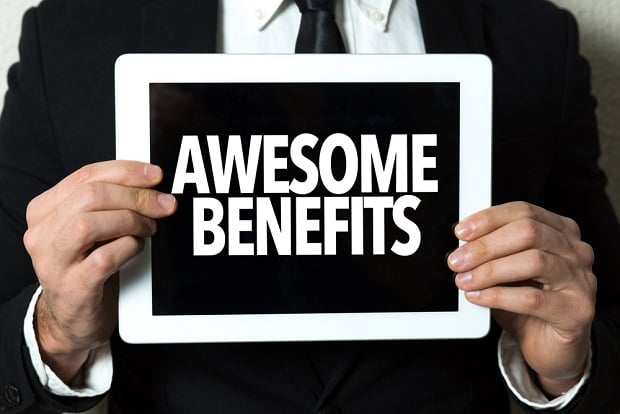 Your workforce is made up of a number of different personas, so you should take steps to ensure that your company provides benefits options that fit everyone's needs. (Photo: Shutterstock)
Your workforce is made up of a number of different personas, so you should take steps to ensure that your company provides benefits options that fit everyone's needs. (Photo: Shutterstock)
The talent market is on fire right now. With unemployment at historic lows, businesses are being forced to buckle down and hustle to recruit and retain the best talent.
Beating out your competition to hire rockstar employees is the key to a strong talent pipeline. Of course, the first way to do that is to ensure that your pay offering is in line with, or ideally, above, the market average when you're hiring. Another facet of your total compensation package that you cannot overlook is your benefits plan. More frequently, job seekers are echoing the needs for competitive pay, but a top-notch benefits plan is a close second in terms of career “must haves.”
Your workforce is made up of a number of different personas, so you should take steps to ensure that your company provides benefits options that fit everyone's needs. Building a holistic plan that appeals to an entire employee base is important because the needs of tenured employees with families to support probably won't align with the needs of a single individual fresh out of college.
|Who are your workplace personas?
Right now, there are five main generations making up today's workforce. These generations have different values and fall into one of these five categories:
Traditionalists (1939-1947): Strongly focused on their careers and largely adhere to social norms; generally, have single-company loyalty.
Baby Boomers (1948-1963): Typically, hardworking and motivated by the three Ps of position, perks, and prestige; they often define themselves by their professional accomplishments.
Generation X (1964-1978): Less committed to a single employer and willing to change jobs to get ahead; they're more tech savvy than previous generations and place a strong value on work/life balance.
Millennials (1979-1991): Have high expectations of their employers, willing to trade high pay for flexible schedules, plugged into technology.
Gen Z (1992 – present): Raised with an iPhone or Android device in their hands, more entrepreneurial and wary of corporate America, highly value personal and professional development opportunities.
|What do they want?
In the 1970s, when the cafeteria plan first made an appearance, rather than being boxed into a traditional benefits program, employees finally had the ability to select the exact types of health care benefits they needed with their payroll deductions taken out pre-tax. Today, the number of traditional and voluntary benefits options available to employees has essentially transformed the humble cafeteria plan into a smörgåsbord of options.
While it's important to consider the workplace personality traits of each generation, this should not be the only factor to consider when you're determining which benefits to offer your workforce. For some, an individual's needs when choosing his benefits plan aren't necessarily going to be driven by his birth year, but by where he is professionally. For example, consider an employee who is 70 years old, has been with a company for 40 years, but isn't quite ready for retirement. She's going to be highly interested in pension plans and 401(k)s. She also places a tremendous value on traditional healthcare benefits.
On the flip side, look at a 30-year old with a spouse and two children. Because he's thinking long-term about his family's needs–i.e., health benefits for his spouse and small kids, retirement down the road–he's also interested in the identical benefits as your 70-year-old employee. Although one is a baby boomer and one is a millennial, they both want the same things, for different reasons. That's why it's so important to tailor conversations about benefits to your audience to be sure you're addressing their particular concerns.
Finally, there are some benefits that have wide, if not universal appeal, such as summer schedules and flexible hours, in-house workout facilities (or discounts for local gym memberships), onsite dining, an open or casual work environment and cell phone and commuter stipends.
Gen Z: A large percentage of Gen Z is likely still on their parents' insurance plans when they enter the workforce, so healthcare benefits might not be something that's immediately top of mind – but don't rule out the appeal of pet insurance! Much like Gen X, many in this group appreciate, or even expect, flexibility and autonomy in the workplace. Additionally, 64% pinpoint career growth opportunities as the priority when they're considering a full-time job, so a comprehensive career development program ranks highly on many of their benefits wish lists. Lastly, consider that digital natives (Gen Z and millennials) who were raised with the constant stimulation of the internet, were also raised to appreciate the need to unplug and rejuvenate, so you might also consider ways to accommodate that desire, such as unlimited PTO and sabbaticals.
Millennials: Millennials generally are more interested in financial benefits. This group may be more driven than prior generations by their belief that Social Security will either run out or be a drop in the bucket when they retire. For plan designers, understanding millennials' insecurities here might help them create innovative programs such as a student loan payoff program (in return for a lower salary) and retirement planning tools or seminars. Also, consider Paid Family Leave, including maternity and paternity options, for millennials who are starting families.
Generation X: According to a MetLife survey, Gen X is busy raising kids, so they're responsible for their children's medical expenses as well as their own. Since this group is likely to have children in age groups that are prone to accidents, especially sports and playground injuries, a solid health insurance plan is important to them. Unfortunately, many businesses need to step up the fine-tuning of their programs because, according to a study conducted by Barclays, 87% of Gen Xers feel their current benefits package isn't flexible enough to meet their changing needs.
Baby boomers: A growing frequency of chronic conditions makes this generation high consumers of health care. So, much like Gen X, 52 percent of boomers would be very interested in having more health plans to choose from, but for very different reasons. They also seek to protect their retirement savings against the risk of unexpected out-of-pocket medical expenses. Additionally, many Boomers are taking care of aging parents and family members, so consider giving them non-traditional leave options. Traditionalists: While they make up only about 3 percent of the workforce, some traditionalists are still trucking along at their jobs. In addition to wanting a solid healthcare benefits plan, Traditionalists are more likely to sign up for voluntary benefits such as cancer or critical illness insurance. They lean more toward a preference for using a PPO rather than the HDHP that younger employees favor.
Bottom line: When you're creating or modifying your benefits plan, it's important to steer clear of a cookie-cutter, one-size-fits-all program. Yes, there are certain things every employee wants from a company: job security, work-life balance, and a good relationship with their employer, but each employee has distinct needs that should be factored in to your final decision.
Read more on how to build a stellar benefits package:
- Expanding and simplifying benefits packages to increase engagement
- Unique benefits to recruit and retain female employees
- Open enrollment tips for benefits managers: Getting ready
 Karen Crone is chief human resources officer for Paycor.
Karen Crone is chief human resources officer for Paycor.
Complete your profile to continue reading and get FREE access to BenefitsPRO, part of your ALM digital membership.
Your access to unlimited BenefitsPRO content isn’t changing.
Once you are an ALM digital member, you’ll receive:
- Breaking benefits news and analysis, on-site and via our newsletters and custom alerts
- Educational webcasts, white papers, and ebooks from industry thought leaders
- Critical converage of the property casualty insurance and financial advisory markets on our other ALM sites, PropertyCasualty360 and ThinkAdvisor
Already have an account? Sign In Now
© 2024 ALM Global, LLC, All Rights Reserved. Request academic re-use from www.copyright.com. All other uses, submit a request to [email protected]. For more information visit Asset & Logo Licensing.








